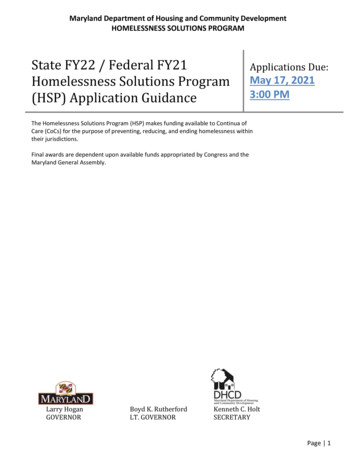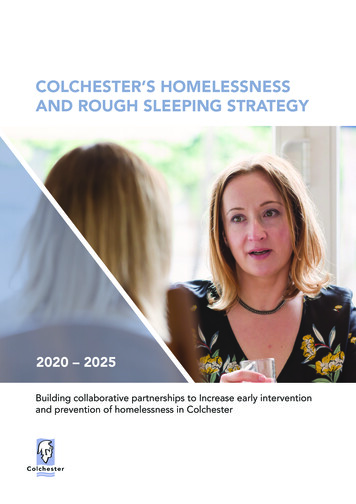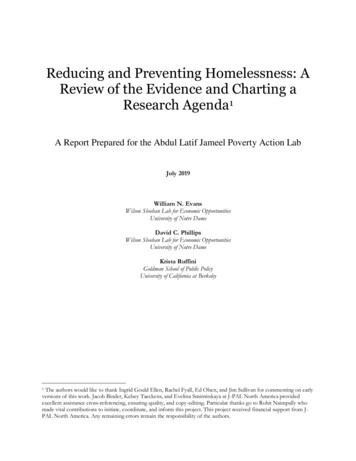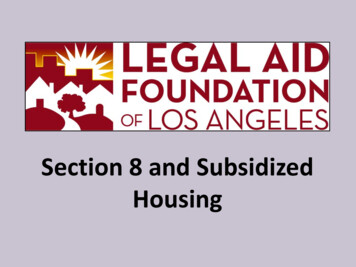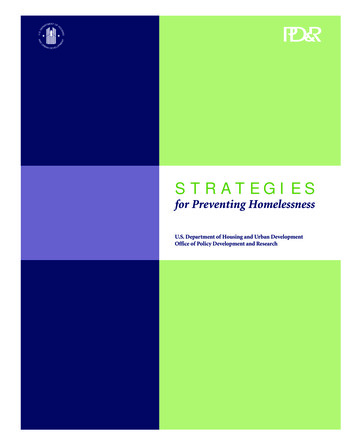
Transcription
HUD-129 Strategies Cover11/7/053:56 PMPage 2U.S. Department of Housingand Urban DevelopmentStrateges for Preventing HomelessnessSTRATEGIESfor Preventing HomelessnessU.S. Department of Housing and Urban DevelopmentOffice of Policy Development and ResearchU.S. Department of Housing and Urban DevelopmentOffice of Policy Development and Research
Visit PD&R’s Web Sitewww.huduser.orgto find this report and others sponsored byHUD’s Office of Policy Development and Research (PD&R).Other services of HUD USER, PD&R’s Research Information Service, include listservs;special interest, bimonthly publications (best practices, significant studies from other sources);access to public use databases; hotline 1-800-245-2691 for help accessing the information you need.
STRATEGIESfor Preventing HomelessnessU.S. Department of Housing and Urban DevelopmentOffice of Policy Development and ResearchPrepared for:Office of Policy Development and ResearchU.S. Department of Housing and Urban DevelopmentPrepared by:Martha R. BurtThe Urban InstituteWashington, DCCarol L. PearsonAnn Elizabeth MontgomeryWalter R. McDonald & Associates, Inc.Rockville, MDMay 2005
ACKNOWLEDGEMENTSMany individuals have assisted us on this project; we would especially like to thank thefollowing: The researchers and program administrators who nominated potential sites. The people we interviewed individually and in on-site meetings, who shared their time,information, and insights with us. We would particularly like to thank our primarycontacts at each of the study communities:Shirley Hendrickson in Hennepin County;Walter Jabzanka at the Massachusetts Department of Mental Health;Jan Marcason at the Mid America Assistance Coalition;Corinne Stevens in Montgomery County, MD;Marcella Maguire and Rob Hess in Philadelphia, PA; andJerene Petersen at Urban Peak. Marina Myhre, our Government Technical Representative from the U.S. Department ofHousing and Urban Development (HUD), who has provided us with thoughtful feedbackand guidance throughout the study. Other HUD staff members who provided helpfulcomments throughout the study include Paul Dornan, Marge Martin, and Kevin Nearyfrom the Office of Policy Development and Research, and Velma Simpson from theOffice of Special Needs Assistance Programs.In addition, we would like to acknowledge Anja Maguire and Madonna Aveni of Walter R.McDonald & Associates, Inc., who provided editorial assistance.We appreciate the significant contributions that the above individuals made to carrying out theresearch and writing of this report. They are not responsible for any remaining errors oromissions. The findings and views herein are those of the contractors and authors.The contents of this report are the views of the contractors and do not necessarily reflect theviews or policies of the U.S. Department of Housing and Urban Development or the U.S.Government.
FOREWORDHomelessness prevention is an essential element of any effort to endhomelessness either locally or nationwide. To close the front door of entry intohomelessness, the central challenge of prevention is targeting our efforts toward thosepeople that will become homeless without the intervention. Providing preventionassistance to people who would not otherwise become homeless is an inefficient use oflimited homelessness dollars.In 2003, HUD contracted with Walter R. McDonald & Associates, Inc., and itssubcontractor, the Urban Institute, to conduct an exploratory study to identifycommunities that have implemented effective and well-targeted community-widehomelessness prevention activities. The study documents these approaches in sixcommunities with the hope that other communities might learn how to carry out similarefforts.This study suggests that a number of elements contribute to homelessnessprevention and a number of promising prevention activities exist. The study identifieselements of community homelessness prevention strategies that seem to lead toreductions in the number of people who otherwise would become homeless. Thecontributing elements include targeting through control of the eligibility screeningprocess; developing community motivation; maximizing mainstream and privateresources; fostering leadership; and ensuring the availability and structure of data andinformation used to track progress, improve on prevention efforts, and facilitate outcomebased contracting. Evidence from the six communities studied indicates that thoseemploying the most elements seem to be more successful at prevention and better able todocument their achievements.Within the context of the aforementioned elements, the study identified fourpromising homelessness prevention activities that may be used alone or in combination aspart of a coherent community-wide strategy: (1) supportive services coupled withpermanent housing, particularly when combined with effective discharge frominstitutions, especially mental hospitals; (2) mediation in Housing Courts; (3) cashassistance for rent or mortgage arrears; and (4) rapid exit from shelter.This study provides insight into approaches that will help prevent homelessness.It is an important contribution to our understanding of how to help homeless Americans.' Secretary
TABLE OF CONTENTSEXECUTIVE SUMMARYWhy Homelessness Prevention?What Makes A Good Prevention Intervention?The Challenge of Creating Effective Prevention StrategiesThe Focus of This StudyCommon Prevention ActivitiesSelecting Communities to StudyPrevention Activities in the Six Study CommunitiesPromising Homelessness Prevention ActivitiesDocumenting Prevention EffectivenessKey Elements of Prevention StrategiesImplications for Policy and PracticeThe Role of Funding AgenciesImplications for Future ResearchConclusionsMaximizing EffectivenessPlanning and Organizing for xiiixxivxxivxxvxxvCHAPTER ONE INTRODUCTIONUnderstanding PreventionTargeting Efficiency—The Key to Prevention EffectivenessWhat “Prevention” Looks Like in American CommunitiesIdentifying Communities to StudyStudy DomainsReport Organization1233689CHAPTER TWO SUMMARY DESCRIPTIONS OF SITESHennepin County, MinnesotaDeveloping the Commitment to PreventionPopulation Served, Targeting PracticesComponents and Organization of the Community StrategyData Collection and UseRelationship to CoC Process and HMISMontgomery County, MarylandDeveloping the Commitment to PreventionPopulation Served, Targeting PracticesComponents and Organization of the Community StrategyData Collection and UseRelationship to CoC Process and HMISMid America Assistance CoalitionDeveloping the Commitment to PreventionPopulation Served, Targeting PracticesComponents and Organization of the Community StrategyData Collection and UseRelationship to CoC Process and HMISMassachusetts Department of Mental HealthDeveloping the Commitment to PreventionPopulation Served, Targeting PracticesComponents and Organization of the Community StrategyData Collection and UseRelationship to CoC Process and 42526
Table of ContentsPhiladelphia, PennsylvaniaDeveloping the Commitment to PreventionPopulation Served, Targeting PracticesComponents and Organization of the Community StrategyData Collection and UseRelationship to CoC Process and HMISUrban PeakDeveloping the Commitment to PreventionPopulation Served, Targeting PracticesComponents and Organization of the Community StrategyData Collection and UseRelationship to CoC Process and HMISSummary26262728282929293030313132CHAPTER THREE USING DATA TO DOCUMENT PREVENTION EFFECTIVENESSDocumenting Prevention EffectivenessProportion of Families Served Who Became HomelessChanges Over TimeCommon Measures of Prevention Among Study CommunitiesData Elements Key to Outcome MeasurementDeveloping Outcome Measures and Collecting Outcome DataAdditional Outcome Measures to ConsiderAdditional Research EffortsTracking Changes Over TimeProgram Evaluation DesignsConclusions353535374040404142424245CHAPTER FOUR KEY ELEMENTS OF PREVENTION STRATEGIESWhat It Takes—Effective Prevention ActivitiesWhat It Takes—Organizing For Preventing HomelessnessElements Affecting Ability to Target WellElements Reflecting Community MotivationElements That Maximize ResourcesElements Affecting Direction, Sustainability, Control, and FeedbackConclusions4747495357586062CHAPTER FIVE POLICY, PRACTICE, AND RESEARCH IMPLICATIONSImplications for Policy and PracticeSelect Effective Prevention ActivitiesDevelop an Efficient Community-Wide Prevention SystemThe Role of Federal AgenciesImplications for Future ResearchControl or Comparison GroupsComparison GroupsLongitudinal REFERENCES75vi
Table of ContentsAPPENDICES77APPENDIX A HENNEPIN COUNTY, MINNESOTAPractices of Potential Interest to Other JurisdictionsDeveloping the Commitment to PreventionComponents and Organization of the Community StrategyFHPAP and Preventing Housing LossRapid ExitStaffing and CaseloadsFunding SourcesData Collection and UseAccess to the DataData ElementsOutcomes—Success at Preventing Shelter Use or Return to ShelterHennepin County Site Visit ParticipantsHennepin County 16A–16A–17A–17A–18A–19A–20APPENDIX B MONTGOMERY COUNTY, MARYLANDPractices of Potential Interest to Other JurisdictionsDeveloping the Commitment to PreventionComponents and Organization of the Community StrategyAccessing MCDHHS Emergency ServicesEligibility Criteria for MCDHHS Emergency ServicesEligibility Determination for MCDHHS Emergency ServicesApproach with LandlordsApproach with Tenants in Subsidized HousingStaffing and CaseloadsFunding Sources and ArrangementsApproach with Transitional HousingApproach with the Larger CommunityApproach with Tenants with Special NeedsPromising New StrategiesData Collection and UseAnalysisInitial FindingsFuture AnalysesCaveats and Limitations of Outcomes DataDocumentation of Reduction in Family HomelessnessMontgomery County Site Visit ParticipantsMontgomery County ��10B–10B–10B–10B–11APPENDIX C MID AMERICA ASSISTANCE COALITIONPractice of Potential Interest to Other JurisdictionsDeveloping the Commitment to PreventionComponents and Organization of the Community StrategyServicesScreening and Eligibility IssuesSelected System ComponentsMainstream Agency –6
Table of ContentsFundingCommunity Relations and AdvocacyData Collection and UseAnalysisInitial FindingsFuture AnalysesLimitations of Data and OutcomesMid America Assistance Coalition Site Visit ParticipantsMid America Assistance Coalition ��9APPENDIX D MASSACHUSETTS DEPARTMENT OF MENTAL HEALTHPractices of Potential Interest to Other JurisdictionsDeveloping the Commitment to PreventionComponents and Organization of the Community StrategyMental Health ServicesDischarge PlanningHousing Supply and DevelopmentResidential Services Other than Permanent HousingServices in Support of Stable HousingPrograms of Assertive Community TreatmentMBHP’s Behavioral Health Care ServicesEmployment ServicesSpecialized ServicesOutreach and ReferralDepartment-Wide Emphasis on the Importance of HousingOutreach to Inpatient Psychiatric UnitsSpringfield/Hamden County Tenancy Preservation ProjectData Collection and UseStatewide Changes, 1992–2003, Excluding Metro BostonMetro BostonEffectiveness of Western Massachusetts’ TPPMassachusetts Site Visit ParticipantsMassachusetts –14D–15D–17D–19D–20D–22APPENDIX E PHILADELPHIA, PENNSYLVANIAPractices of Potential Interest to Other JurisdictionsDeveloping the Commitment to PreventionComponents and Organization of the Community StrategyPhiladelphia’s Behavioral Health Care SystemThe System for Adults in Adult Inpatient CareSpecial Projects for Corrections Discharges of Inmates with Serious Mental IllnessFunding for Casework and Prevention ServicesWho is Served?Data Collection and UsePhiladelphia Site Visit ParticipantsPhiladelphia –12E–13E–14E–15viii
Table of ContentsAPPENDIX F URBAN PEAKPractices of Potential Interest to Other JurisdictionsDeveloping the Commitment to PreventionComponents and Organization of the Community StrategyOutreachDrop-In ServicesEmergency Shelter and Support ServicesPermanent Supportive HousingCommunity Advocacy and CollaborationData Collection and UseInnovative Data Collection MethodsRecommended Data AnalysesNext StepsUrban Peak Site Visit ParticipantsUrban Peak ��8F–9F–10F–10F–11F–12F–12APPENDIX G METHODSSite SelectionSite VisitsData Analysis PlansG–1G–1G–3G–5APPENDIX H GLOSSARYH–1ix
Table of ContentsExhibitsExhibit ES.1.Exhibit 1.Exhibit 2.Exhibit 3.Exhibit 4.Exhibit 5.Exhibit 6.Exhibit 7.Exhibit 8.Exhibit 9.Exhibit 10.Exhibit A.1.Exhibit A.2.Exhibit B.1.Exhibit C.1.Exhibit D.1.Exhibit D.2.Exhibit D.3.Exhibit D.4.Exhibit D.5.Exhibit D.6.Exhibit D.7.Exhibit F.1.Exhibit G.1.Exhibit G.2.Exhibit G.3.Organizing for Community-Wide Homelessness PreventionHomelessness Prevention ActivitiesStudy SitesHomelessness Prevention and Intervention OptionsProportion of Families Entering a Homeless Shelter Within 12 MonthsFollowing Receipt of Rent or Mortgage Assistance or Rapid Exit ServicesChange in Housing Barriers of Sheltered Families in Hennepin CountyChanges in Massachusetts DMH Community Residential Capacity and Changesin Proportion of Homeless Admissions and DischargesOutcome Measures for Urban Peak, 2000–2004Outcome Status of Closed Cases at the Tenancy Preservation Project of theMental Health Association, Inc., of Springfield, MAOrganizing for Community-Wide Homelessness PreventionHennepin County Housing Barrier ScreenHennepin County Housing Barrier ScreenChange in Housing Barriers of Sheltered FamiliesOutcome Measures for FamiliesRecipients of Rent and Mortgage Assistance Who Became Homeless theFollowing YearGrowth in DMH Residential Housing Capacity, Affiliated Housing Statewide,and Metro Boston Capacity, 1991–2004DMH Funding for Community-Based Housing and Services, 1999–2004Changes in Homeless and Total Admissions to DMH Continuing Care Units,Excluding Metro Boston, 1993–2003Changes in Homeless Admissions and Discharges in DMH Continuing CareUnits, Excluding Metro Boston, 1993–2003Changes in Proportions of Homeless Admissions and Discharges to AllAdmissions in DMH Continuing Care Units, Excluding Metro Boston,1993–2003Discharge Destinations of People Leaving Private Acute Psychiatric Care, MetroBoston, SFY 2002–2004TPP Case Status, Total Closed, by Diagnosis, and Comparison CasesOutcome Measures for Urban Peak Denver, 2000–2004Canvass Discussion GuideStudy SitesSite Visit �2G–3G–6
EXECUTIVE SUMMARYWHY HOMELESSNESS PREVENTION?Every day in the United States, families and single adults who have never been homeless losetheir housing and enter a shelter or find themselves on the streets. No matter how effectiveservices are to help people leave homelessness, reducing homelessness or ending it completelyrequires stopping these families and individuals from becoming homeless. Policies and activitiescapable of preventing new cases, often described as “closing the front door” to homelessness, areas important to ending homelessness as services that help those who are already homeless toreenter housing (National Alliance to End Homelessness, 2000).Most communities in the United States offer a range of activities to prevent homelessness. Themost widespread activities provide assistance to avert housing loss for households facingeviction. Other activities focus on moments when people are particularly vulnerable tohomelessness, such as at discharge from institutional settings (e.g., mental hospitals, jails, andprisons). Given that the causes and conditions of becoming homeless are often multifaceted,communities use a variety of strategies to prevent homelessness.By definition, the intent of prevention is to stop something from happening. The worse theeffects of what one is trying to prevent, the more important it is to develop effective preventionstrategies, and the more one is willing to accept partial prevention if complete prevention is notpossible.Homelessness is a very undesirable condition, both for the people it affects and for society ingeneral. The effects of homelessness on children, for example, make it easy to see why manycommunities offer interventions to help keep families with children in housing. Compared topoor, housed children, homeless children have worse health (more asthma, upper respiratoryinfections, minor skin ailments, gastrointestinal ailments, parasites, and chronic physicaldisorders), more developmental delays, more anxiety, depression and behavior problems, poorerschool attendance and performance, and other negative conditions (Buckner, 2004; Shinn andWeitzman, 1996). There are also indications that negative effects increase the longerhomelessness continues, including more health problems (possibly from living in congregateshelters or in cars and other places not meant for habitation) and more mental health symptomsof anxiety, depression, and acting out brought about by the disruptions in routines, relationships,and environments that homelessness entails (Buckner, 2004).Even housing instability negatively impacts children. Analyses of the National Health InterviewSurvey show strong associations between moving three or more times and increased behavioral,emotional, and school problems (Shinn and Weitzman, 1996), even when poverty does notcomplicate the picture. These findings suggest that even if families receiving preventionassistance would not become literally homeless without assistance, reducing the number of timesthey move may be worth the investment of paying rent, mortgage, or utility arrearages.Effects of homelessness on parents in homeless families are similar to those of their children,with the exception of school-related problems (Shinn and Weitzman, 1996). The effects ofhomelessness on single adults are also grim. Homeless individuals report poor health (37 percentxi
Executive Summaryversus 21 percent for poor housed adults), and are more likely to have life-threatening contagiousdiseases such as tuberculosis and HIV/AIDS (Weinreb, Gelberg, Arangua, and Sullivan, 2004).The risk of homelessness is relatively high among poor households in the United States. Aboutone in 10 poor adults and children experience homelessness every year (Burt, Aron, and Lee,2001; Culhane, Dejowski, Ibanez, Needham and Maccia, 1994; Link, Susser, Stueve, Phelan,Moore, and Struening. 1994, 1995). Homelessness exacerbates the negative effects of extremepoverty on families and individuals.The litany of negative effects of homelessness makes it easy to see why a community wouldwant to prevent it. But being convinced that action is needed and knowing what action to take aretwo different things. Despite the theoretical importance of prevention as the only intentionalpractice that will reduce the number of new cases of homelessness, public funders are oftenreluctant to invest in homelessness prevention strategies. In part, this reluctance stems from fearthat funds could benefit people other than those likely to become homeless, thereby diluting thealready limited public resources committed to homeless people, or invested in activities that havenot been proven effective to prevent homelessness.WHAT MAKES A GOOD PREVENTION INTERVENTION?To prevent something from happening, ideally one would know what causes it. The next bestthing is to be able to predict in advance when, or to whom, it will happen. Knowing causes orhaving the ability to predict causes improves the odds of being able to design effectiveinterventions.The causes of some undesirable things are clear and the solutions obvious, if not always simpleor inexpensive. Bacteria cause some diseases, so to prevent these diseases one must dosomething about the bacteria. 1 One can kill the bacteria in a number of ways, by washing orusing antibacterial agents on one’s hands, by using sterile procedures in operating rooms, or byassuring that the water in dishwashers reaches 180 degrees. Other approaches seek to prevent thebacteria from reaching people, including killing mosquitoes that carry malaria or yellow fever,fleas that carry typhus, or ticks that spread Lyme disease. Still other approaches (vaccines) makepeople more resistant to the bacteria.Unfortunately, the causes of homelessness are not as clear as is true for many diseases, andprediction is thus less certain. Research has identified many antecedents of homelessness that canserve as predictors. But knowing such factors about a set of people will not predict homelessnesswith certainty. For example, in their groundbreaking study comparing poor housed and homelessfamilies in New York City the best that Shinn and her colleagues were able to do was correctly1Even this example is not so simple, as some people will not get a disease even if infected with the relevantbacteria. As with homelessness, the presence of risk factors does not guarantee that the outcome will follow.xii
Executive Summaryclassify a family as homeless or not homeless 66 percent of the time (Shinn et al., 1998). Theprediction equation used 10 factors, including race and ethnicity, childhood poverty, beingpregnant or having an infant, being married or living with a partner, current domestic violence,childhood disruption, and four housing factors—overcrowding, doubling up, not having ahousing subsidy, and frequent moves. The single factor “facing eviction” predicted homelessnessonly 20 percent of the time (that is, 20 percent of families facing eviction eventually becamehomeless).Few communities desiring to prevent homelessness among families will be able to eliminatethese risk factors, at least in the short run. That is, they cannot do the equivalent of killing thebacteria. But communities can use knowledge of these factors to increase the odds that they aredelivering homeless prevention services to families who would very likely become homelesswithout it, and would be well advised to use more factors than just “threat of eviction.”Communities can use the identified predictive factors mentioned above to screen families forhigh homelessness risk and then target their resources toward the highest-risk families.Factors differentiating adults who have experienced homelessness from those who have notinclude having an income less than 50 percent of poverty level; the presence of mental health,substance abuse, and chronic physical health problems; and a history of incarceration. Adversechildhood experiences including physical and sexual abuse and out-of-home placement alsopredicted the likelihood that an adult had experienced homelessness (Burt, Aron, and Lee, 2001).THE CHALLENGE OF CREATING EFFECTIVE PREVENTION STRATEGIESThis study concentrated on the primary prevention of homelessness—that is, on preventing newcases of homelessness and stopping people from ever becoming homeless. It also examinedsecondary and tertiary prevention activities, but only as part of a community’s comprehensiveprevention strategy. Secondary prevention focuses on intervening early during a first spell ofhomelessness to help the person leave homelessness and not return. Tertiary prevention activitiesseek to end long-term homelessness, thus preventing continued homelessness, and were the focusof an earlier HUD study (Burt et al., 2004).It is relatively easy to offer prevention activities but difficult to develop an effective communitywide prevention strategy. Such a prevention strategy needs to offer effective prevention activitiesand do so efficiently. Effective activities must be capable of stopping someone from becominghomeless (primary prevention) or ending their homelessness quickly (secondary prevention). Anefficient system must target well, delivering its effective activities to people who are very likelyto become homeless unless they receive help.Inefficiency is widely considered to be the common failing of local prevention strategies andactivities; they simply target too broadly. The people receiving the intervention are not uniformlyat very high risk of homelessness, so relatively few would actually become homeless evenwithout the intervention. Based on the goal of prevention, a prevention strategy is not efficientand “wastes” resources if it uses them to assist people who would not have become homelesswithout the service. Briefly stated, poor targeting leads to an inefficient strategy and inefficientstrategies are rarely effective. This study sought evidence that particular prevention activitiesxiii
Executive Summarywere effective, and also sought to understand what makes a community’s homelessnessprevention strategy efficient.By what standard should one judge the effectiveness of a prevention activity? The answer to thisquestion depends on the type of prevention one attempts. The Centers for Disease Control andPrevention of the U.S. Department of Health and Human Services maintains a Web site called“The Guide to Community Prevention Services” (www.thecommunityguide.org), through whichit recommends activities whose effectiveness is considered proven for preventing healthproblems as diverse as suicide, youth violence, and smoking. Rates of change achieved byprevention activities that this guide describes as having strong evidence of effectiveness rangefrom very low for primary prevention activities to very high for tertiary interventions. Forinstance, raising the price of cigarettes reduces smoking initiation by about 4 percent, and, whencombined with extensive media campaigns, by about 8 percent. At the other extreme, therapeuticfoster care for chronically delinquent violent youth—a tertiary intervention—produces a70 percent reduction in violence compared to regular group home treatment.The lesson for homelessness prevention efforts is that sometimes even relatively smallpercentage changes may be judged effective when the issue is primary prevention, both becausethe target population is so large and diverse, and therefore difficult to influence, and also becausethe consequences of failure are many and costly. When looking at the impacts of interventionsdesigned for secondary and tertiary prevention, however, one should look for somewhat strongereffects because the target population is well-defined and interventions can be more preciselytailored.THE FOCUS OF THIS STUDYTo learn more about effective prevention strategies, the U.S. Department of Housing and UrbanDevelopment (HUD) contracted in 2003 with Walter R. McDonald & Associates, Inc. (WRMA)and its partner, Urban Institute (UI), to conduct this study. Specifically, the study’s objectiveswere to: Identify communities that have implemented community-wide strategies to preventhomelessness and can document their effectiveness; Describe these strategies and their component activities for other communities and thefield at large; and Review community data that measure achievements in preventing homelessness andprovide evidence that the prevention activities were effective.Common Prevention ActivitiesTo give the concept of “homelessness prevention” some concreteness, the study team examinedContinuum of Care (CoC) applications for 2004 to identify the activities that communitiesxiv
Executive Summaryinclude in the prevention component of their CoCs. 2 One cluster of activities was found inalmost every application. It included counseling and advocacy to help households connect toresources and housing, as well as budget and credit counseling. It also included in-kindemergency assistance (food, clothing, transportation vouchers, and occasionally furniture andmedical care); and cash assistance with rent, mortgage, or utility payments to avert eviction.A smaller proportion of communities also offered a second set of activities aimed at preventinghomelessness. These activities included the following: legal and other assistance to retainhousing; mental health, corrections, child welfare, and Temporary Assistance for Needy Families(TANF) agencies making commitments to house their clients as part of their service obligation;and strategies that involve more than one public agency working together to preventhomelessness. An example of the latter is mental health and corrections agencies collaborating toprevent homelessness at institutional release for mentally ill inmates.Selecting Communities to StudyArmed with a general knowledge of prevention activities and target populations (e.g., families,people leaving institutions), the study team sought communities to include in this study thatrepresented a range of approaches and focal populations, and also met two criteria specified byHUD. Community-wide strategy: Primary prevention activities that represent a consciouscommitment of the community to prevent homelessness. They go beyond the activitiesof a single agency to encompass the whole community in a structured and coordinatedway, although they may have a specific population focus. Data documenting effectiveness: The community collects and analyzes data capable ofshowing that its prevention efforts do or do not prevent homelessness.To identify appropriate communities, the study team started by contacting national experts onhomelessness, who suggested 45 points of contact in 28 communities. A canvass of thesecommunities eventually identified six communities that met both HUD criteria reasonably well.If the only criterion had been “community-wide,” more communities would have been included.However, most communities with community-wide prevention strategies did not maintain dataon program effectiveness. The lead agencies in the six communities selected for further studywere: Hennepin County Human Services
subcontractor, the Urban Institute, to conduct an exploratory study to identify communities that have implemented effective and well-targeted community-wide homelessness prevention activities. The study documents these approaches in six communities with the hope that other communities might learn how to carry out similar efforts.

